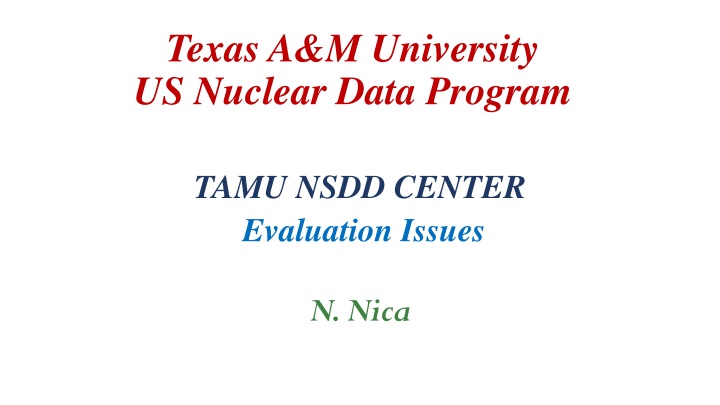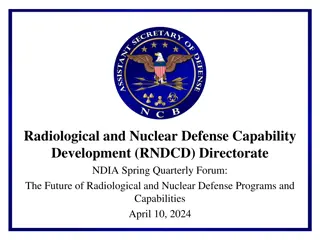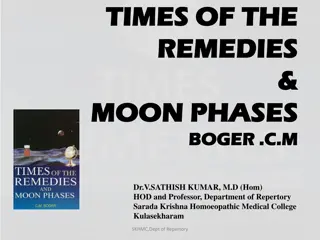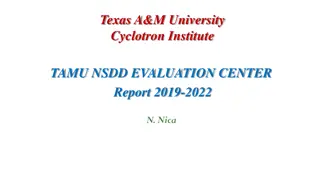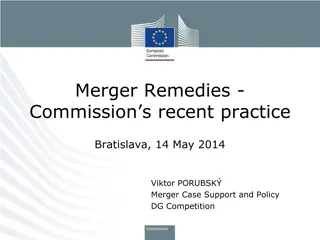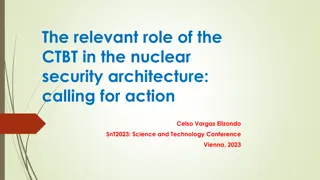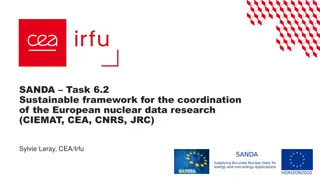Challenges in Nuclear Data Program Evaluation and Remedies
Exploring evaluation challenges in a nuclear data program, including issues with decay cases and ambiguous notations. Remedies such as redesignating levels and clarifying decay probabilities are discussed to address these challenges.
Download Presentation

Please find below an Image/Link to download the presentation.
The content on the website is provided AS IS for your information and personal use only. It may not be sold, licensed, or shared on other websites without obtaining consent from the author.If you encounter any issues during the download, it is possible that the publisher has removed the file from their server.
You are allowed to download the files provided on this website for personal or commercial use, subject to the condition that they are used lawfully. All files are the property of their respective owners.
The content on the website is provided AS IS for your information and personal use only. It may not be sold, licensed, or shared on other websites without obtaining consent from the author.
E N D
Presentation Transcript
Texas A&M University US Nuclear Data Program TAMU NSDD CENTER Evaluation Issues N. Nica
1. Case study for typical EC decay cases Typical case of a beta decay to an isomer of unknown energy Favored 11/2- to 11/2- + +decay, Q( )=10630 keV Other two lower levels known, of which one is the g.s., unfavored for the + +decay The decay goes to a level 5000 5000 keV The decay drawing is not drawing the range, so it is confusing! Remedies ???
1. Case study for typical EC decay cases Typical case of a beta decay to an isomer of unknown energy Favored 11/2- to 11/2- + +decay, Q( )=10630 keV Other two lower levels known, of which one is the g.s., unfavored for the + +decay The decay goes to a level 5000 5000 keV The decay drawing is not drawing the range, so it is confusing! Remedy 1: Remove the , +table The + +decay does exist and so the 11/2- level, even if its energy is not known Not shown the level it would be more confusing, even wrong
1. Case study for typical EC decay cases Typical case of a beta decay to an isomer of unknown energy Favored 11/2- to 11/-2 decay fot Q( )=10630 keV Other two lower levels known, of which one is the g.s. unfavored for the decay The decay goes to a level 5000 5000 keV The decay drawing is not drawing the range, so it is confusing! Remedy 2: Redesignate (5 103 5) level Maintain the + +table Rename the level as: 147ER E 10630-X That would restore the correctness and good sense However, it should be checked: Whether it can be implemented in JAVA-NDS (also fmtchk should be modified to accept the change) Whether other unwanted effects are propagated on other codes
2. A beta-delayed particle decay ambiguity Remedy 1 Example 1 Following publications notations P1n, P2n % -1n, % -2n % +1p can be acceptable form for the respective probabilities (as for evaluator in example 2) This in turn would made available the notation % -n % +p to be used for indicating the total delayed-neutron decay . Example 2 However, that would consequently demand the systematic replacement of all % -n of with % -1n. That would be a greater problem than the one here scrutinized Remedy 2 Fortunately, there is a simple solution for the ambiguity: Keep % -n, % -2n unchanged for beta-delayed one and two neutrom decays For the total delayed-neutron decay use instead the new notation: % - n that would need to replace only the fewer cases of such occurrences % -1n For the beta-delayed proton emission use the corresponding notations % +p, % +2p, % + p % -1n % -n
3. The S(n)+x, S(2n)+y range situation L 3759.6 9 (1/2+,3/2+,5/2+) ? L 2312+X R L 8652+Y R
4. Extend the capability of JAVA_RULER PROPOSAL, based on JAVA-RULER s the key feature calculate ICC by BrIcc Design a new button (unless is already done but I ignored its existence) to analyze each transition with incomplete information and get the RUL comparisons for these situations: If rays are assigned D, or Q, or higher multipoles, JAVA-RULER can run the possible case scenarios, e.g., E2 vs. M2, E1 vs. M1, etc., combining s if known If no is assigned, JAVA-RULER can calculate RUL comparisons for =0 If no multipoles are assigned, JAVA-RULER can calculate all combinations for J=1 to 4. If BR is not known, JAVA-RULER can calculate RUL comparisons for BR=1 The corresponding JAVA-RULER output will contain only the transition with incomplete information. RULER can be used to discriminate between different gamma-ray multipolarities when T1/2 is known as value or limit However, RULER is able to output the Recommended Upper Limits (RUL) comparisons with calculated B(XL)(W.u.) only if all needed parameters are known (T1/2 , A, E , BR, , ). Tom Burrows recommended to rerun RULER for a given transition by varying the different E s / M s However, changing parameters and rerunning the code especially when looking to test for multiple s is tedious and time consuming
